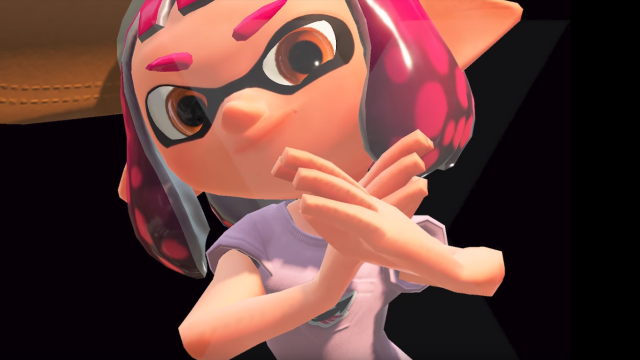Splatoon 2‘s face is all inky rainbows and cutesy cephalopods. It would be an adorable, idyllic wonderland, if not for the fact that controlling all of those snuggable urchins are real-life humans, who are often bad.
If you’ve tromped around Splatoon 2 for more than a few hours, you might have stumbled upon a few unseemly things in its player lobby where squid-kid avatars hang out. Above their heads are messages and drawings that players submit to the game.
Some are gorgeous, photorealistic portraits of Kotaku‘s Mike Fahey. Others are grade-A shitposts (“I play Splatoon in the bathroom”). And sometimes, they’re straight-up hate speech.
Content Warning: The following post describes transphobia.
A few weeks ago, to kick of LGBTQ Pride month, Splatoon 2 players posted effusive messages in support of queer sexuality. “I’m gay + trans & I love cephalopods,” read one message plastered with hearts. “Happy pride!” read another. The lobby was alive with these messages.
Then, I saw an alarming and straight-up hateful message in the lobby: “Transgender is a mental illness.” Without getting into why that’s an egregious and ill-informed thing to say, seeing something so charged in the lobby of an E-rated game was jarring.
At E3 last week, I sat down with Splatoon producer Hisashi Nogami and told him about that message in hopes of learning how exactly notes like that slip through into the public eye.
“We really don’t want people to use the plaza here as a way to hurt people or say hurtful things to other people or do anything considered against the law,” said Nogami. He explained that comments and posts that receive “likes” from other players are more likely to be seen by more players. Posts are continually uploaded, so ones that don’t receive likes will simply fade into obscurity.
“We do have a portion of our development team that is responsible for spotting the worst offenders when it comes to comments and artwork and making sure those don’t get seen,” Nogami said, but noted that it’s a small team.
When I asked what will provoke Splatoon 2‘s developers to take down a post, Nogami explained that Japan has a game rating system called CERO, the Computer Entertainment Rating Organisation.
A CERO rating of “A,” which Splatoon 2 has, should contain “no content that should offend children.” Splatoon 2‘s developers will remove posts if they don’t abide by those vague guidelines or break the law — if they see the post.
In practice, that system lets people who share hurtful opinions with posters who upvote hurtful posts into visibility, which Nogami says is “kind of like the real world.”
“We know a lot of topics are something someone feels positively about and another person might feel negatively about,” Nogami told me. “We don’t want to bring the hammer down too hard on everything.
“And so as long as something hasn’t risen to the top for the wrong reasons, something that would be violating the rating for some reason, we try and let the system basically sort it out. We really hope that people use this system as a means of communication and celebrating the game.”
Well, hope springs eternal. Then come the shitposts.

Comments